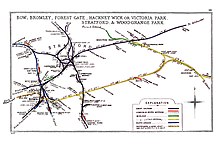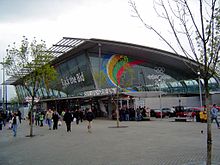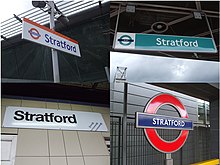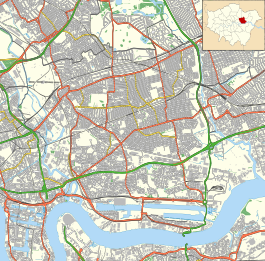|
Stratford station
Stratford is a major multi-level interchange station serving the town of Stratford and the mixed-use development known as Stratford City, in the London Borough of Newham, East London for London Underground, London Overground, Docklands Light Railway (DLR) and Elizabeth line services. National Rail services also operate on the West Anglia Main Line and the Great Eastern Main Line, 4 miles 3 chains (6.5 km) from Liverpool Street. It is the fifth busiest railway station in Britain,[17] the busiest station in London outside the London station group,[18] and is the busiest station on the London Underground network outside Travelcard Zone 1.[17] On the London Underground, the station is on the Central line between Mile End and Leyton stations. It is also the eastern terminus of the Jubilee line and the next station towards west is West Ham. On the DLR, it is a terminus for some trains and for others it is a through-station between Stratford High Street and Stratford International. On the Overground, it is the terminus of the Mildmay line; on the main line it is served by Elizabeth line stopping services between Paddington and Shenfield and by medium- and longer-distance services operated by Greater Anglia to and from numerous destinations in the East of England. There are also limited off-peak services operated by c2c connecting to the London, Tilbury and Southend line to Shoeburyness. The station was opened in 1839 by the Eastern Counties Railway. Today it is owned by Network Rail and is in Travelcard zone 2/3.[19] To distinguish it from Stratford-upon-Avon in Warwickshire it is sometimes referred to as Stratford (London),[2] or as Stratford Regional to differentiate it from Stratford International, which is some 400 yards (370 m) to the north.[1] Stratford served as a key travel hub for the 2012 Olympic and Paralympic Games held in London.[20]
HistoryEarly days: 1839–62Stratford station was opened on 20 June 1839 by the Eastern Counties Railway (ECR) with the first station building being located on Angel Lane which crossed the line on an over-bridge to the east of the station. The Northern and Eastern Railway opened a section of its authorised line from Broxbourne to join the ECR at Stratford on 15 September 1840.[21] As well as a station, a railway works was built adjacent to the line to Broxbourne. This and the engine shed later expanded into the area to the west of the station which is now occupied by a shopping centre and Stratford International station. The ECR tracks were originally set to a gauge of 5 ft (1,524 mm) on the recommendation of engineer John Braithwaite. At this time there was no legislation dictating the choice of gauge and indeed the directors favoured the Great Western Railway's broad gauge 7 ft (2,134 mm). Braithwaite persuaded the directors otherwise on the grounds of additional cost but recommended the 5 ft gauge in an effort to reduce wear on locomotive parts. This choice meant that the Northern & Eastern Railway who were planning to share the ECR line between Stratford and Bishopsgate were forced to adopt the same gauge.[22] With the extension of the ECR in the early 1840s it became apparent that standard gauge 4 ft 8+1⁄2 in (1,435 mm) was a more realistic choice and subsequently between September and October 1844 the gauge conversion was carried out. At the same time the associated Northern & Eastern Railway was also converted. New station buildings were built in 1847 replacing the original structure on Angel Road. These were located in the V between the Cambridge and Colchester lines and access was via Station Road.[23] The line through the low level platforms first opened in 1846 as a goods only branch as far as Thames Wharf. The bridge under the main line was too low for many locomotives, so a number of engines were equipped with hinged chimneys in order they could operate the line.[24] On opening there was also a line that linked what is now known as the Great Eastern Main Line directly to the docks enabling through running from Colchester to Thames Wharf. The docks and associated railway networks expanded with passenger services to North Woolwich starting in 1847.[25] There was an accident at Stratford station on 18 July 1846 when an up goods train ran into the back of a passenger train from Ipswich. There were 10 passengers seriously injured one of whom later died.[26] In 1854 the newly opened London Tilbury and Southend Railway served Stratford joining the main line at Forest Gate Junction a few miles north. Their services generally served Fenchurch Street and were routed via the Bow Road route (although that station was not opened at this time) although some carriages were detached at Stratford for onward working to Bishopsgate. This practice was discontinued in 1856 as passengers preferred the more conveniently sited (for the city) Fenchurch Street. In connection with the introduction of the new LTSR services a third line was built from Stratford to Bow Junction which was used by down Fenchurch Street services and a new platform face opened.[23] It soon became apparent that congestion was a problem at Stratford and by 1856 permission was sought to build a line from Barking to Gas Factory Junction (Bow) which was opened in 1858. After that LTSR trains were no longer routed via Stratford.[27] By 1855 there were links from both the low and high-level stations to the North London Line as well as a spur that enabled trains from Liverpool Street to North Woolwich to avoid Stratford altogether (although this served Stratford Market station) which was a short distance away. Services from the North London line normally started from Victoria Park and ran through to Stratford Market. This service operated from 1866 until 1874 and was operated by the GER and North London Railway in alternate years up until 31 October 1874.[28] The North London Railway was also running through Stratford high level with two return trains per day from Hampstead Road (later renamed Chalk Farm) via Victoria Park and Forest Gate Junctions to Tilbury which commenced on 1 July 1855 and finished 30 September.[29] Services to Loughton commenced on 22 August 1856 and used the Lea Valley platforms, leaving the main line at Loughton Branch Junction half a mile north of Stratford. Initially nine trains per day operated to Fenchurch Street (Bishopsgate on Sundays) on this route.[30] By the 1860s the railways in East Anglia were in financial trouble, and most were leased to the ECR; they wished to amalgamate formally, but could not obtain government agreement for this until 1862, when the Great Eastern Railway was formed by amalgamation. Thus Stratford became a GER station in 1862.[31] Great Eastern Railway: 1862–1923The Loughton branch was extended to Ongar on 24 April 1865 and by 1874 there were a total of 40 trains each day (10 terminating at Loughton, 18 at Epping and 12 at Ongar) with most serving the newly opened Liverpool Street although a few peak hour services continued to serve Fenchurch Street.[32] Even after LTSR services were routed away from Stratford in 1858 working remained intense. Following an accident in 1866 the accident report noted that "Stratford needs complete re-arranging, extending and fitting with modern improvements for working points and signals, as in its present state it appears to be quite insufficient for the traffic that passes through it". Although one of the signal boxes had interlocking fitted soon after, the poor state of GER finances saw little further work until 1877 when a significant rebuilding of Stratford took place. Another short-lived North London Railway service operated in September and October 1866, linking Chalk Farm with Barking (again routed via Victoria Park and Forest Gate Junctions). This service was withdrawn due to congestion, and one of the services was involved in a collision on 10 September 1866 with 20 passengers being injured.[29][33] The 1877 rebuilding saw a number of changes made, which were:
Between 1886 and 1887, improvements were made to the station buildings and the canopies extended.[23] On 26 December 1886, a train was derailed at Stratford station as facing points had not been properly locked into position. Fortunately there was no loss of life.[34] By 1889, traffic on the GER had grown to such an extent, that quadrupling the section from Bethnal Green to Bow Junction and from Maryland Point-Romford was proposed. Once again significant changes which were implemented between 1891 and 1893 and included:
In 1896, the low-level line was lowered under the main line so locomotives no longer required hinged chimneys.[24] By July 1897, it was apparent that the decision not to include platforms on both Through lines was causing some operational difficulty. To address this a new platform serving the Up Through line was opened in 1900. The Fairlop Loop opened on 1 May 1903 and services generally ran as an out and back circle from either Liverpool Street or Fenchurch Street. The routing of these services was Liverpool Street – Stratford – Ilford – Fairlop Loop – Woodford – Stratford – Liverpool Street) and Liverpool Street – Stratford – Woodford – Fairlop Loop – Ilford – Stratford – Liverpool Street in the reverse direction.[36]  On 1 January 1923, the GER became part of the London & North Eastern Railway. London and North Eastern Railway: 1923–47By the 1930s electric tramways were taking a lot of traffic from the railway and proposals were drawn up to electrify the lines from Liverpool Street to Shenfield using the 1500 V DC system. By 1938 the major contracts were let and work started. Despite the commencement of the Second World War in 1939, work was initially continued on the scheme, however, the scheme was postponed in late 1940. In February 1946, the LNER announced work would recommence. On 5 October 1946, the new interchange platforms with the Central line (see below) were opened.[37] London Underground Central line services started on 4 December 1946, extended from Liverpool Street station in new tunnels after being delayed due to the Second World War.[38] The line was further extended to Leyton on 5 May 1947 and then to the former Great Eastern Railway branch lines to Epping, Ongar and Hainault progressively until 1957.[39] Prior to this date trains to and from Epping and Ongar had used the currently numbered platforms 11 and 12 and diverged from the Broxbourne line about half a mile north of the station. Trains for the Hainault loop used either these platforms or the currently numbered platform 5 (up) or 8 (down) diverging from the Great Eastern Main Line at a junction between Ilford and Seven Kings which has since been redeveloped as part of the Ilford Carriage sheds. British Railways: 1948–96 The nationalisation of Britain's railways saw the operation of Stratford station pass to British Railways Eastern Region. A new station building was designed by Thomas Bennett and opened in 1948.[40] Progress on electrification that had been halted by the Second World War resumed after the end of hostilities. The line between Liverpool Street and Stratford was electrified from 3 December 1946, and the full electrification of the Shenfield line at 1500 V DC was completed in September 1949. The electric service between Liverpool Street to Shenfield was inaugurated on 26 September 1949 but services were run to steam timings with a number of steam trains still operating. The full electric service officially commenced on 7 November 1949 (although a full dummy run had taken place the previous day). Two days earlier services to Fenchurch Street via Bow Road were withdrawn.[41] On 8 April 1953, 12 people were killed and 46 were injured as a result of a rear-end collision in a tunnel just to the east of Stratford station, caused by driver error after a signal failure.[42][43] Between 1960 and 1961, the 1,500 V DC electrification to Shenfield line which had been extended to Southend and Chelmsford was converted to 6.25kV ac.[44] In the autumn of 1980, conversion of the overhead electrification from 6.25kV ac to the standard supply of 25kV ac of the Liverpool St. to Shenfield line.[45] The Docklands Light Railway (DLR) opened on 31 August 1987 reusing redundant rail routes through the Bow and Poplar areas to reach the new Docklands developments on the Isle of Dogs.[46][47] Initially the line used one of the south facing bays which had been built for the Fenchurch street via Bow Road service (but never used).[48] Privatisation era: 1996–present In the 1990s, the low-level station was substantially rebuilt as part of the Jubilee Line Extension works.[49] This work included three additional surface platforms and a train crew building (designed by Troughton McAslan) and a large steel and glass building that encloses much of the low-level station, providing a new ticket hall (designed by Wilkinson Eyre).[49] The old ticket hall, at the eastern end of the station and connected via a subway, has since been demolished. The Jubilee line opened to passengers on 14 May 1999 as far as North Greenwich station, and to Green Park and Stanmore in November 1999.[50][51] In preparation for the 2012 Olympic and Paralympic Games, the capacity of the station was tripled at a cost of around £200m, with construction work funded by the Olympic Delivery Authority (£125m) and Westfield.[52][53] It was estimated that around 120,000 people would use the station at peak periods during the Games.[54][55] Construction took place between 2005 and 2011, and work included:[56][52][54]
Since the turn of the millennium, "passenger movements"[a] have risen from around 40 million a year in 2006 to 128 million in 2019, making it one of Britain's major rail interchanges.[60] From 6 November 2022, Elizabeth line services enter the central tunnel built as part of the Crossrail project, allowing direct trains to Heathrow and Reading via Paddington.[61] All trains, save for some early morning, late night and peak hour services, go via Whitechapel. Work started in 2023 to add a new entrance to the station at its southwestern corner, adjacent to the Jubilee line concourse, allowing access to the Carpenters Estate.[62] This will reducing walking time for local residents by up to 20 minutes.[62] The new entrance opened on 10 July 2024.[63] Station layout  High-level platforms
The high-level platforms run at right angles to the low-level, roughly east–west. The Docklands Light Railway serving platforms 16 and 17 passes beneath the high-level station. Except for platforms 4A and 4B, access from the main station entrance is via subways, one of which links the Jubilee line platforms directly to platforms 3 and 5 to 10. Another subway, which had served the old entrance to the station, was re-opened in September 2010.[65]
Low-level platformsThese platforms are at ground level and run north–south. Platforms 13 to 16 are served by a footbridge (with lifts and escalators) from the main station entrance, while platform 17 adjoins directly onto the main station concourse.
Services Stratford is a major rail hub with services operated by Greater Anglia, London Overground (on the Mildmay line), the Elizabeth line and London Underground (on the Central and Jubilee lines). The typical off-peak service in trains per hour (tph) is: ElectrificationAll lines at Stratford are electrified, although a few passenger and freight services which pass through this station are hauled by diesel locomotives. At one time there were four different systems of electrification in use, a record for any station in London. However, since the diversion of the North London line from the low-level to the new high-level platforms these trains have changed the electrical system they use while at this station. The remaining systems used are:
In 1949, the Great Eastern Main Line through Stratford was electrified at 1,500 V DC overhead before being converted to 6.25 kV AC 50 Hz overhead in 1960 and converted again to 25 kV in about 1976.[70] GeographyChannelsea RiverThe Channelsea River is a culverted major tidal stream that is one of the Bow Back Rivers that flow into the Bow Creek part of the River Lea. It flows under Stratford station and rises along the Jubilee line platforms to the south. It was diverted in the 19th century by the Great Eastern Railway and again during construction of the Jubilee line platforms in the 1990s.[citation needed] Nearby facilitiesGoods facilitiesThere were three primary goods facilities in the Stratford area in the steam age, although the nearby Stratford Works and engine shed generated their own traffic. A short distance to the north of Stratford station (on the line to Cambridge) there were marshalling yards at Temple Mills. There was a small goods yard north of the station on the east side of the line which occupied a constrained site. The mainstay of traffic was domestic coal although shortly before closure in the 1960s the site was used as a reception point for concrete components for the building of tower blocks in Newham.[71] There was a small depot at Carpenters Road about a quarter of a mile south of Stratford station. Opened in 1900, the depot consisted of four long sidings and primarily dealt with coal and building materials. It was closed on 7 December 1964.[72] There was a large depot at Stratford Market railway station. All of these three facilities were operated by the Great Eastern Railway up until 1923 before being taken over by the London & North Eastern Railway until nationalisation in 1948 when they became part of British Railways Eastern Region. There was also a goods terminal at Bow operated by the Midland Railway which is still open today mostly for building materials. This yard operated as the terminal for building materials for the adjacent Olympics site.[73] Between Stratford and Maryland stations Windmill Lane cattle pens existed on the down side of the line whilst four private sidings belonging to Young & Martens were located on the up side. During the 1960s part of the Stratford Works site was converted to the London International Freight Terminal (LIFT) which opened in 1967 and there was a freight liner terminal that operated on the far side of the Stratford railway complex (on the Channelsea Loop line) between 1967 and 1994. The former site is now occupied by the international station and shopping centre.[74][75] Stratford InternationalThe nearby Stratford International station opened on 30 November 2009 (for preview services only). Since 13 December 2009 Southeastern began its full domestic high-speed service between London St Pancras, directly to Ebbsfleet International[76] and Ashford in Kent. The Docklands Light Railway 'Stratford International' extension has provided a link between the two stations since 31 August 2011.[77] There is also a walking route between the two stations passing through Westfield Stratford City Shopping Centre. Despite Stratford International's name, no international trains call there, and Eurostar (currently the only international operator) has no plans to do so. Passengers instead interconnect on high-speed trains travelling to either London St Pancras or Ebbsfleet in Kent, there are a number of other potential operators that may use the station for international services. These include Deutsche Bahn's proposed London-Frankfurt/Amsterdam service.[78] Stratford CityIn preparation for the Olympics and the Stratford City development, a new north-facing exit and ticket hall has been built. Both existing passenger subways have been extended north to connect with the ticket hall, and the abandoned subway at the eastern end of the station, which formed part of the old station complex, has been reopened and refurbished to allow interchange between platforms 3–12 and the new high-level platforms 1 & 2.[79] A new pedestrian bridge has also been built to connect Stratford shopping centre with the Stratford City development. This also connects the mezzanine-level ticket hall with the northern one. The northern ticket hall and the footbridge opened along with Westfield Stratford City on 13 September 2011. Bus stationsStratford bus station is to the south of the station and Stratford City bus station is to the north. Both are served by bus services right across London and to the Queen Elizabeth Olympic Park. Future proposalsStansted Express may call at Stratford in the future via the West Anglia Main Line, reconnecting the two to each other.[80][may be outdated as of May 2022] The Hall Farm Curve link could be reinstated allowing a Liverpool Street to Chingford service via Stratford. Designs for new services have been suggested to reduce journey times between Chingford and Stratford to 20 minutes, and high-frequency journeys between Walthamstow Central and Stratford to 12 minutes from the current duration of about 35 minutes.[81][may be outdated as of May 2022] Rebuild of stationIn the 2020s, work is underway planning a rebuild of the station.[60][82] "Passenger movements"[b] have grown by 90 million in 13 years,[82] and this is predicted to rise by 60% by 2041, leading to overcrowding.[60] Three different plans have been outlined, ranging from "modest changes to a major redevelopment of the station".[60][83] Redevelopment would also include transit-oriented development including new homes and offices.[82] NotesReferences
External linksWikimedia Commons has media related to Stratford station.
|
|||||||||||||||||||||||||||||||||||||||||||||||||||||||||||||||||||||||||||||||||||||||||||||||||||||||||||||||||||||||||||||||||||||||||||||||||||||||||||||||||||||||||||||||||||||||||||||||||||||||||||||||||||||||||||||||||||||||||||||||||||||||||||||||||||||||||||||||||||||||||||||||||||||||||||||||||||||||||||||||||||||||||||||||||||||||||||||||||||||||||||||||||||||||||||||||||||||||||||||||||||||||||||||||||||||||||||||||||||||||||||||||||||||||||||||||||||||||||||||||||||||||||||||||||||||||||||||||||||||||||||||||||||||||||||||||||||||||||||||||||||||||||||||||||||||||||||||||||||||||||||||

